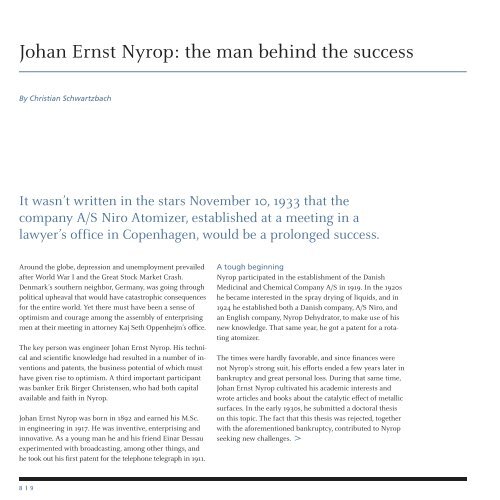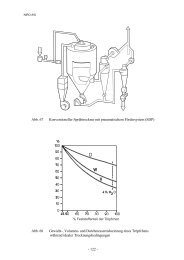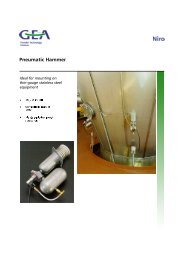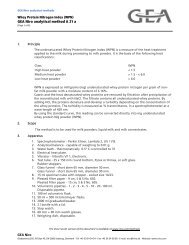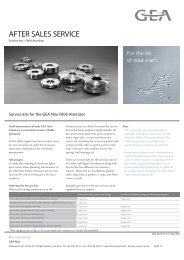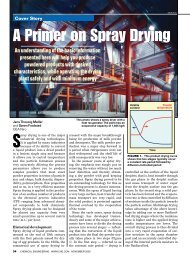41119_Niro jubilaeumsbog_blok_uk - GEA Niro
41119_Niro jubilaeumsbog_blok_uk - GEA Niro
41119_Niro jubilaeumsbog_blok_uk - GEA Niro
You also want an ePaper? Increase the reach of your titles
YUMPU automatically turns print PDFs into web optimized ePapers that Google loves.
Johan Ernst Nyrop: the man behind the success<br />
By Christian Schwartzbach<br />
It wasn’t written in the stars November 10, 1933 that the<br />
company A/S <strong>Niro</strong> Atomizer, established at a meeting in a<br />
lawyer’s office in Copenhagen, would be a prolonged success.<br />
Around the globe, depression and unemployment prevailed<br />
after World War I and the Great Stock Market Crash.<br />
Denmark’s southern neighbor, Germany, was going through<br />
political upheaval that would have catastrophic consequences<br />
for the entire world. Yet there must have been a sense of<br />
optimism and courage among the assembly of enterprising<br />
men at their meeting in attorney Kaj Seth Oppenhejm’s office.<br />
The key person was engineer Johan Ernst Nyrop. His technical<br />
and scientific knowledge had resulted in a number of inventions<br />
and patents, the business potential of which must<br />
have given rise to optimism. A third important participant<br />
was banker Erik Birger Christensen, who had both capital<br />
available and faith in Nyrop.<br />
Johan Ernst Nyrop was born in 1892 and earned his M.Sc.<br />
in engineering in 1917. He was inventive, enterprising and<br />
innovative. As a young man he and his friend Einar Dessau<br />
experimented with broadcasting, among other things, and<br />
he took out his first patent for the telephone telegraph in 1911.<br />
8 | 9<br />
A tough beginning<br />
Nyrop participated in the establishment of the Danish<br />
Medicinal and Chemical Company A/S in 1919. In the 1920s<br />
he became interested in the spray drying of liquids, and in<br />
1924 he established both a Danish company, A/S <strong>Niro</strong>, and<br />
an English company, Nyrop Dehydrator, to make use of his<br />
new knowledge. That same year, he got a patent for a rotating<br />
atomizer.<br />
The times were hardly favorable, and since finances were<br />
not Nyrop’s strong suit, his efforts ended a few years later in<br />
bankruptcy and great personal loss. During that same time,<br />
Johan Ernst Nyrop cultivated his academic interests and<br />
wrote articles and books about the catalytic effect of metallic<br />
surfaces. In the early 1930s, he submitted a doctoral thesis<br />
on this topic. The fact that this thesis was rejected, together<br />
with the aforementioned bankruptcy, contributed to Nyrop<br />
seeking new challenges.


